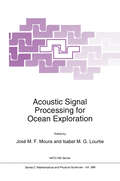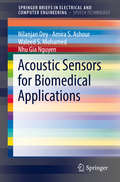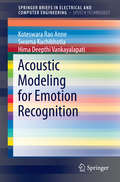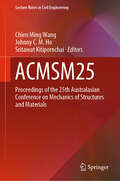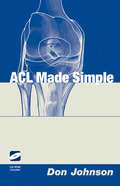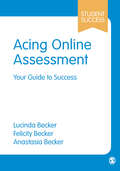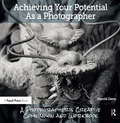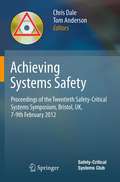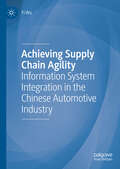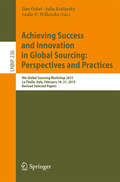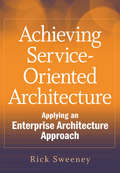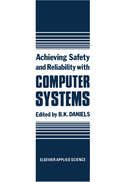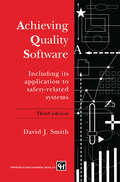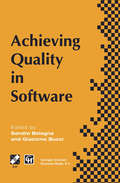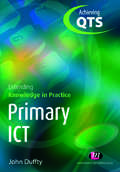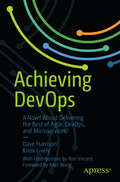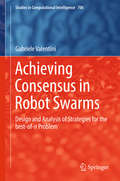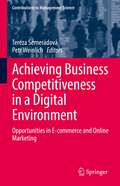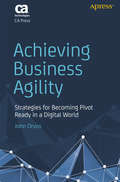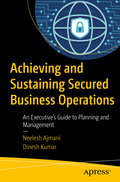- Table View
- List View
Acoustic Signal Processing for Ocean Exploration (Nato Science Series C: #388)
by J. M. F Moura Isabel M. G. LourtieAcoustic Signal Processing for Ocean Explortion has two major goals: (i) to present signal processing algorithms that take into account the models of acoustic propagation in the ocean and; (ii) to give a perspective of the broad set of techniques, problems, and applications arising in ocean exploration. The book discusses related issues and problems focused in model based acoustic signal processing methods. Besides addressing the problem of the propagation of acoustics in the ocean, it presents relevant acoustic signal processing methods like matched field processing, array processing, and localization and detection techniques. These more traditional contexts are herein enlarged to include imaging and mapping, and new signal representation models like time/frequency and wavelet transforms. Several applied aspects of these topics, such as the application of acoustics to fisheries, sea floor swath mapping by swath bathymetry and side scan sonar, autonomous underwater vehicles and communications in underwater are also considered.
Acoustic Sensors for Biomedical Applications (SpringerBriefs in Speech Technology)
by Nilanjan Dey Amira S. Ashour Waleed S. Mohamed Nhu Gia NguyenIn this book, application-related studies for acoustic biomedical sensors are covered in depth. The book features an array of different biomedical signals, including acoustic biomedical signals as well as the thermal biomedical signals, magnetic biomedical signals, and optical biomedical signals to support healthcare. It employs signal processing approaches, such as filtering, Fourier transform, spectral estimation, and wavelet transform. The book presents applications of acoustic biomedical sensors and bio-signal processing for prediction, detection, and monitoring of some diseases from the phonocardiogram (PCG) signal analysis. Several challenges and future perspectives related to the acoustic sensors applications are highlighted. This book supports the engineers, researchers, designers, and physicians in several interdisciplinary domains that support healthcare.
Acoustic Modeling for Emotion Recognition (SpringerBriefs in Speech Technology)
by Koteswara Rao Anne Swarna Kuchibhotla Hima Deepthi VankayalapatiThis book presents state of art research in speech emotion recognition. Readers are first presented with basic research and applications – gradually more advance information is provided, giving readers comprehensive guidance for classify emotions through speech. Simulated databases are used and results extensively compared, with the features and the algorithms implemented using MATLAB. Various emotion recognition models like Linear Discriminant Analysis (LDA), Regularized Discriminant Analysis (RDA), Support Vector Machines (SVM) and K-Nearest neighbor (KNN) and are explored in detail using prosody and spectral features, and feature fusion techniques.
Acoustic Cues in the Disambiguation of Polysemous Strings (Synthesis Lectures on Speech and Audio Processing)
by Maja GwóźdźThis book provides an analysis of acoustic features of polysemous strings and an implementation of a speech disambiguation program based on the phonetic information. Throughout the book, the term ‘polysemous string’ refers to idioms with plausible literal interpretations, restrictive and non–restrictive relative clauses, and the same expressions used as quotations and appearing in a non–quotational context. The author explains how, typically, context is sufficient to determine the intended meaning. But there is enough evidence in psycholinguistic and phonetic literature to suspect that these superficially identical strings exhibit different acoustic features. In the experiment presented in the book, the participants were asked to read short excerpts containing corresponding elements of polysemous strings placed in the same intonational position. The acoustic analyses of ditropic pairs and subsequent statistical tests revealed that there is almost no difference in the duration, pitch, or intensity in literal and figurative interpretations. However, the analysis of relative clauses and quotations demonstrated that speakers are more likely to use acoustic cues to differentiate between the two possible readings. The book argues that the acoustic analysis of polysemous phrases could be successfully implemented in designing automatic speech recognition systems in order to improve their performance in disambiguating polysemous phrases.Analyzes acoustic features of polysemous strings and an implementation of a speech disambiguation programIncludes evidence that superficially identical strings exhibit different acoustic featuresArgues that acoustic analysis of polysemous phrases can be successfully implemented in automatic speech recognition
ACMSM25: Proceedings of the 25th Australasian Conference on Mechanics of Structures and Materials (Lecture Notes in Civil Engineering #37)
by Chien Ming Wang Johnny C. M. Ho Sritawat KitipornchaiThis book presents articles from The Australasian Conference on the Mechanics of Structures and Materials (ACMSM25 held in Brisbane, December 2018), celebrating the 50th anniversary of the conference. First held in Sydney in 1967, it is one of the longest running conferences of its kind, taking place every 2–3 years in Australia or New Zealand. Bringing together international experts and leaders to disseminate recent research findings in the fields of structural mechanics, civil engineering and materials, it offers a forum for participants from around the world to review, discuss and present the latest developments in the broad discipline of mechanics and materials in civil engineering.
ACL Made Simple
by Don JohnsonACL Made Simple is a book/CD-ROM combination that educates orthopedic residents, athletic trainers, and various medical support staff about the fundamentals of ACL injuries. The content is both thorough and practical. Readers will benefit from comprehensive discussions of diagnosis, partial tears, treatment options, operative techniques, and complications. This definitive guide also outlines a six-month rehabilitation program complete with goals, stages, and exercises. More than 150 photographs and diagrams illuminate key concepts. A CD-ROM keyed to each chapter complements the text and makes it easy for users to locate sections of particular interest. The numerous graphics and narrated video clips are dynamic tools that highlight topics including the mechanism of injury, physical examination, and surgical techniques.
Acing Online Assessment: Your Guide to Success (Student Success)
by Lucinda Becker Felicity Becker Anastasia BeckerFacing an online assessment? Here’s how to ace it. This straightforward guide helps you translate your existing skills into an online environment. It enables you to transition from understanding familiar, offline assessments to succeeding in formal online assessments by breaking down what you are being asked to do - then shows you how to prepare, where to get help and what to do on the day. From presentations to portfolios, it demonstrates that, once you understand this new way of being assessed, you can make the most of working online to improve your grades and excel in your work. It also: Equips you with strategies to help manage anxieties around online assessment. Highlights the challenges and benefits that are unique to online assessment. Demonstrates how to make the most of feedback to support your development as a self-reflective learner. With each chapter built around key student questions, this guide is perfect for dipping into for any type of online assessment.
Acing Online Assessment: Your Guide to Success (Student Success)
by Lucinda Becker Felicity Becker Anastasia BeckerFacing an online assessment? Here’s how to ace it. This straightforward guide helps you translate your existing skills into an online environment. It enables you to transition from understanding familiar, offline assessments to succeeding in formal online assessments by breaking down what you are being asked to do - then shows you how to prepare, where to get help and what to do on the day. From presentations to portfolios, it demonstrates that, once you understand this new way of being assessed, you can make the most of working online to improve your grades and excel in your work. It also: Equips you with strategies to help manage anxieties around online assessment. Highlights the challenges and benefits that are unique to online assessment. Demonstrates how to make the most of feedback to support your development as a self-reflective learner. With each chapter built around key student questions, this guide is perfect for dipping into for any type of online assessment.
Acing Online Assessment: Your Guide to Success (Student Success)
by Lucinda Becker Felicity Becker Anastasia BeckerFacing an online assessment? Here’s how to ace it. This straightforward guide helps you translate your existing skills into an online environment. It enables you to transition from understanding familiar, offline assessments to succeeding in formal online assessments by breaking down what you are being asked to do - then shows you how to prepare, where to get help and what to do on the day. From presentations to portfolios, it demonstrates that, once you understand this new way of being assessed, you can make the most of working online to improve your grades and excel in your work. It also: Equips you with strategies to help manage anxieties around online assessment. Highlights the challenges and benefits that are unique to online assessment. Demonstrates how to make the most of feedback to support your development as a self-reflective learner. With each chapter built around key student questions, this guide is perfect for dipping into for any type of online assessment.
Achieving Your Potential As A Photographer: A Creative Companion and Workbook
by Harold DavisComing from the perspective that true inspiration and great image making are at the core of any high-level photographic endeavour, Achieving Your Potential as a Digital Photographer presents an organized and cohesive plan for kickstarting creativity, and then taking the resulting work into the real world. The ideas presented have been formulated by Harold Davis over many years working as a creative artist and award-wining photographer, and in the celebrated workshops he has developed and led all around the world. These concepts are presented with accompanying exercises so that readers can put them into everyday practice as well as workbook pages bound into the book for note taking and journaling. This book will enrich your photographic practice whether the goal is simply to enrich your photography or to make money from your work.
Achieving Your Potential As A Photographer: A Creative Companion and Workbook
by Harold DavisComing from the perspective that true inspiration and great image making are at the core of any high-level photographic endeavour, Achieving Your Potential as a Digital Photographer presents an organized and cohesive plan for kickstarting creativity, and then taking the resulting work into the real world. The ideas presented have been formulated by Harold Davis over many years working as a creative artist and award-wining photographer, and in the celebrated workshops he has developed and led all around the world. These concepts are presented with accompanying exercises so that readers can put them into everyday practice as well as workbook pages bound into the book for note taking and journaling. This book will enrich your photographic practice whether the goal is simply to enrich your photography or to make money from your work.
Achieving Systems Safety: Proceedings of the Twentieth Safety-Critical Systems Symposium, Bristol, UK, 7-9th February 2012
by Chris Dale Tom AndersonAchieving Systems Safety contains papers presented at the twentieth annual Safety-critical Systems Symposium, held in Bristol, UK, in February 2012.The Symposium is for engineers, managers and academics in the field of system safety, across all industry sectors, so the papers making up this volume offer a wide-ranging coverage of current safety topics, and a blend of academic research and industrial experience. They include both recent developments in the field and discussion of open issues that will shape future progress.The topics covered by the 20 papers in this volume include vulnerabilities in global navigation satellite systems; safety culture and community; transport safety; cyber-attacks on safety-critical systems; improving our approach to systems safety; accidents; assessment, validation and testing; safety standards and safety levels.The book will be of interest to both academics and practitioners working in the safety-critical systems arena.
Achieving Supply Chain Agility: Information System Integration in the Chinese Automotive Industry
by Yi WuThis book identifies factors of information system (IS) integration that influence supply chain agility and illustrates how IS integration can achieve greater supply chain agility. Also considering the consequent operational impacts that arise from IS-enabled supply chain agility, the author presents real-life examples through interviews and surveys to explore how IS integrations affect supply chain agility in the context of the Chinese automotive industry. The ability to swiftly respond to competitive challenges is a key element in industry 4.0 and organisations with agile supply chains are better prepared to respond to uncertainties and changes. This book develops and presents guidelines on the deployment of information system integration in order to achieve efficient agile supply chains.
Achieving Success and Innovation in Global Sourcing: 9th Global Sourcing Workshop 2015, La Thuile, Italy, February 18-21, 2015, Revised Selected Papers (Lecture Notes in Business Information Processing #236)
by Ilan Oshri Julia Kotlarsky Leslie P. WillcocksThis book constitutes revised selected papers from the 9th international Global Sourcing Workshop 2015, held in La Thuile, Italy, in February 2015. The 14 contributions included were carefully reviewed and selected from 40 submissions. The book offers a review of the key topics in outsourcing and offshoring, populated with practical frameworks that serve as a tool kit to students and managers. The range of topics covered is wide and diverse, but predominately focused on how to achieve success and innovation in global sourcing. The topics discussed combine theoretical and practical insights regarding challenges that industry leaders, policy makers, and professionals face. Case studies from various organizations, industries and countries are used extensively throughout the book to illustrate results and findings.
Achieving Service-Oriented Architecture: Applying an Enterprise Architecture Approach
by Rick SweeneyA complete, comprehensive methodology and framework for adopting and managing a successful service oriented architecture environment Achieving Service-Oriented Architecture helps to set up an SOA Architecture Practice defining the policies, procedures, and standards that apply not just to IT developers but to the entire corporation as it relates to business applications. Why a new architectural approach is necessary for your business to achieve all the value SOA has to offer Focuses on setting up an enterprise architecture practice for service-oriented architecture Discusses the implementation and governance processes for SOA Defines and describes an overall architectural framework for managing SOA assets at an enterprise architecture level Shows how to set up and run an SOA Enterprise Architecture Practice using the methodology and framework presented Defining how an Architecture Practice can transform itself and your corporation to maximize the benefits of the SOA approach, Achieving Service-Oriented Architecture provides a pragmatic enterprise architecture approach and framework for implementing and managing service oriented architecture from a business organization and business practices perspective. Note: CD-ROM/DVD and other supplementary materials are not included as part of eBook file.
Achieving Service-Oriented Architecture: Applying an Enterprise Architecture Approach
by Rick SweeneyA complete, comprehensive methodology and framework for adopting and managing a successful service oriented architecture environment Achieving Service-Oriented Architecture helps to set up an SOA Architecture Practice defining the policies, procedures, and standards that apply not just to IT developers but to the entire corporation as it relates to business applications. Why a new architectural approach is necessary for your business to achieve all the value SOA has to offer Focuses on setting up an enterprise architecture practice for service-oriented architecture Discusses the implementation and governance processes for SOA Defines and describes an overall architectural framework for managing SOA assets at an enterprise architecture level Shows how to set up and run an SOA Enterprise Architecture Practice using the methodology and framework presented Defining how an Architecture Practice can transform itself and your corporation to maximize the benefits of the SOA approach, Achieving Service-Oriented Architecture provides a pragmatic enterprise architecture approach and framework for implementing and managing service oriented architecture from a business organization and business practices perspective. Note: CD-ROM/DVD and other supplementary materials are not included as part of eBook file.
Achieving Safety and Reliability with Computer Systems
by B. K. DanielsThe safe operation of computer systems, in both their software and hardware continues to be a key issue in many real time applications, when people, environment, investment or goodwill can be at risk. Such applications include the monitoring and control of high energy processes, of nuclear and chemical plants, of factory automation, of transportation systems, or funds transfer and of communication and information systems. This book represents the proceedings of the 1987 Safety and Reliability Society Symposium held in Altrincham, UK, 11-12 November 1987. It is thus part of the series of proceedings for Society Events, which in previous years have not addressed the topic of the Safety and Reliability of Computer Systems. The book is also part of another series of reports, and is closely related to the Elsevier Book "Safety and Reliability of Programmable Electronic Systems" which I edited in 1986, and the series of workshops known as SAFECOMP held in 1979, 1982, 1983, 1985, 1986 which are referenced in some of the papers. The structure of the book represents the structure of the Symposium itself. The session titles, and the papers as selected represent the current practice in many industries. The trend is towards more industrial usage of Formal Methods, and tools to support these methods, whilst continuing to make best use of Software Engineering, Safety and Reliability Assessment, and accumulated experience.
Achieving Quality Software: Including Its Application to Safety-Related Systems
by D.J. SmithThe rapid growth in use of programmable technology, in nearly all sectors of Engineering, is a well-known established trend and one which there is every reason to believe will continue into the foreseeable future. The drivers of this trend include cost, flexibility, rich functionality and certain reliability and safety advantages. However, as explained in this book, these advantages have to be carefully weighed against a number of dis advantages which, amongst other things, have fundamental implications for reliability and safety. Ideally, a programmable system would be viewed as a fusion of hardware, software and user (or 'skinware'), operating under a set of environmental conditions. To date, such a unifying model does not exist and so hardware, software and human factors are still considered largely as three separate disciplines, albeit with certain interdependencies. Established techniques are available which enable the engineer to develop systems comprising purely hardware components to a prescribed reliability and performance. Software, however, is fundamentally different in a number of ways, and does not lend itself to equivalent analysis. A major problem with software is its poor 'visibility', and consequently the great difficulty in understanding and predicting its behaviour in all cir cumstances. This results in the ever-present software design flaws, or 'bugs', which have plagued the software industry from its beginnings.
Achieving Quality in Software: Proceedings of the third international conference on achieving quality in software, 1996 (IFIP Advances in Information and Communication Technology)
by S. Bologna G. BucciSoftware quality is a generalised statement difficult to agree or disagree with until a precise definition of the concept of "Software Quality" is reached in terms of measurable quantities. Unfortunately, for the software technology the basic question of: • what to measure; • how to measure; • when to measure; • how to deal with the data obtained are still unanswered and are also closely dependant on the field of application. In the past twenty years or more there have been a number of conferences and debates focusing on the concept of Software Quality, which produced no real industrial impact. Recently, however, the implementation of a few generic standards (ISO 9000, IEEE etc.) has produced and improved application of good practice principles at the industrial level. As a graduate in PhYSiCS, I still believe it is a long way before the concept of Software Quality can be defined exactly and measured, if ever. This is way I think the AQuIS series of conferences is important, its object begin to provide a platform for the transfer of technology and know how between Academic, Industrial and Research Institutions, in the field of Software Quality. Their objects are: • to provide a forum for the introduction and discussion of new research breakthroughs in Software Quality; • to provide professional Software Quality engineers with the necessary exposure to the results of current research; • to expose the research community to the problems of practical application of new results.
Achieving QTS Extending Knowledge in Practice
by John DufftyStill the biggest concern for many on initial teacher training courses is the acquisition of subject knowledge and the ability to translate that into effective teaching. This book addresses this - building on the core subject knowledge covered in the Achieving QTS series and relating it to classroom practice. It supports trainees in extending and deepening their knowledge of ICT and demonstrating how to apply it to planning and implementing lessons. Practical and up-to-date teaching examples are used to clearly contextualize subject knowledge. A clear focus on classroom practice helps trainees to build confidence and develop their own teaching strategies.
Achieving DevOps: A Novel About Delivering the Best of Agile, DevOps, and Microservices
by Dave Harrison Knox LivelyBen is stuck. A development lead with a strong vision for how the intersection of development and operations at his office can be improved, he can’t help but feel overwhelmed and discouraged by common problems such as slow turnaround time, rushed and ineffective handover documentation, mounting technical debt, and a lagging QA process. What steps should Ben take to build the momentum needed to create positive changes within his company? In this unique business novel by Dave Harrison and Knox Lively, two DevOps professionals with years of diverse experience in the industry, you follow Ben as he solves work frustrations in order to adopt Agile, DevOps, and microservices architectures for his organization. Achieving DevOps addresses the “Now what?” moment many DevOps professionals face on their journey. The story provides you with the knowledge you need to navigate the internal political waters, build management support, show measurable results, and bring DevOps successfully into your organization.Come away with practical lessons and timeless business concepts. You’ll know how to effect change in a company from the bottom up, gain support, and instill a pattern of progressively building on success. Experience Ben’s progress vicariously in Achieving DevOps and bridge the gap between inspiration and the implementation of your own DevOps practices.Who This Book Is ForThose serving as change agents who are working to influence and move their organizations toward a DevOps approach to software development and deployment: those working to effect change from the bottom up such as development leads, QA leads, project managers, and individual developers; and IT directors, CTOs, and others at the top of an organization who are being asked to lend their support toward DevOps implementation efforts
Achieving Consensus in Robot Swarms: Design and Analysis of Strategies for the best-of-n Problem (Studies in Computational Intelligence #706)
by Gabriele ValentiniThis book focuses on the design and analysis of collective decision-making strategies for the best-of-n problem. After providing a formalization of the structure of the best-of-n problem supported by a comprehensive survey of the swarm robotics literature, it introduces the functioning of a collective decision-making strategy and identifies a set of mechanisms that are essential for a strategy to solve the best-of-n problem. The best-of-n problem is an abstraction that captures the frequent requirement of a robot swarm to choose one option from of a finite set when optimizing benefits and costs. The book leverages the identification of these mechanisms to develop a modular and model-driven methodology to design collective decision-making strategies and to analyze their performance at different level of abstractions. Lastly, the author provides a series of case studies in which the proposed methodology is used to design different strategies, using robot experiments to show how the designed strategies can be ported to different application scenarios.
Achieving Business Competitiveness in a Digital Environment: Opportunities in E-commerce and Online Marketing (Contributions to Management Science)
by Tereza Semerádová Petr WeinlichThe COVID-19 pandemic has been a very strong reminder that the future economic development of any country is more than ever influenced by its ability to ramp-up digital competitiveness. Consequently, enterprises were pushed to assess and develop the possibilities offered by e-commerce and online marketing tools. In this book, experts outline the prerequisites for such online marketing competitiveness and compare the current level of digital marketing competitiveness in Europe by using publicly available macro and micro-level data. The authors present their analyses and recommendations including interviews with over 125 online marketers and e-commerce specialists and present the lessons from digitalization of over 600 SMEs.
Achieving Business Agility: Strategies for Becoming Pivot Ready in a Digital World
by John OrvosKnow how to lead and establish business agility in your organization. Benefit from clear, actionable steps based on change management truths that have been long underutilized and have limited the success of agile expansion into your business. This book provides a pragmatic framework for leading your business toward shifting to an agile mindset. Achieving Business Agility offers strategies and concrete examples to engage business executives and will teach you how to effectively execute these strategies. Whether you are a delivery executive, a change advocate, a consultant, a business leader, or a newcomer to agile, you will learn clear actions from a practical, business-oriented perspective that is vital to effect change and bring agile into your business. The book is structured in three sections. The first provides you with a deep understanding of each of four strategies. The second section tells the story of a company that applied these strategies through the eyes of several key players. The last section helps you get started applying what you learned in your own company. What You’ll Learn Get the attention of your executives by alerting them to a company problem that can impact them personally and create a sense of urgency to address itCollaborate with your executives in a way that gets them to open up and to see how their operating model is a contributing cause to the company problemDemonstrate how your executives can specifically benefit from a new agile business operating model and address the company problemCreate a reinforcement structure on a larger scale to establish agile as the new standard operating model in your organization Who This Book Is For Managers, business leaders, and consultants at/for large enterprises or small startups who want their company to better compete in today’s fast-moving markets that present threats and opportunities at every turn. No agile expertise is required.
Achieving and Sustaining Secured Business Operations: An Executive’s Guide to Planning and Management
by Neelesh Ajmani Dinesh KumarProactively plan and manage innovation in your business while keeping operations safe and secure. This book provides a framework and practices to help you safeguard customer information, prevent unauthorized access, and protect your brand and assets.Securing company operations is a board-level discussion. Across all industries, companies are pouring millions of dollars into taming cybercrime and other related security crime. Achieving and Sustaining Secured Business Operations presents a holistic approach looking top down, bottom up, and sideways. The end goal is to achieve and sustain a safe environment to conduct secured business operations while continuously innovating for competitive advantage.What You’ll LearnDiscover why security, specifically secured business operations, needs to be part of business planning and oversight by design and not left to technologists to make the business caseDetermine what you can do in your role and in your organization to drive and implement integration and improvements in planning and managing secured business operations in conjunction with other business planning and management activitiesChoose ways in which progress toward achieving and sustaining secured business operations can be measuredUnderstand best practices for organizing, planning, architecting, governing, monitoring, and managing secured business operationsCreate a framework, including methods and tools for operationalizing assessment, planning, and ongoing management of secured business operationsUse cases and potential case studies for various industries and business models Who This Book Is For Chief executive officers and their leadership team; chief operations officers; chief information officers and their leadership team; chief information security officers; business functional middle managers; and enterprise, solution, and information technology architects
